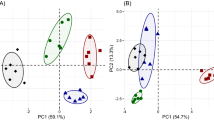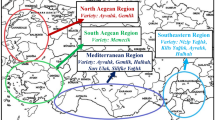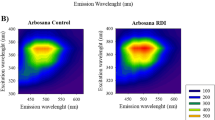Abstract
Thirty-seven olive oil samples belonging to cultivars: Ntopia, Koroneiki, Thiaki, Asprolia and Lianolia were collected from four Western Greek islands. Samples were subjected to the following physicochemical analyses: acidity, peroxide value, K232, K270, ΔK indices, chlorophyll and carotenoid contents, along with fatty acids in an effort to characterize and mainly classify olive oil samples according to cultivar. Multivariate analysis of variance (MANOVA) showed that the following parameters: acidity, chlorophyll, carotenoid, myristic acid, margaric acid, stearic acid, arachidic acid, and eicosenoic acid were significant (p < 0.05) for the classification of olive oil cultivars. The aforementioned parameters were subjected to linear discriminant analysis (LDA) providing a correct classification rate of 91.9% and 81.1% using the original and cross-validation methods, respectively. Finally, the application of quality control analysis such as Pareto chart showed that with only two variables namely acidity and chlorophyll content, the investigated cultivars could be differentiated, providing thus, a rapid and costless methodology for olive oil cultivar differentiation.



Similar content being viewed by others
References
Owen RW, Haubner R, Würtele G, Hull WE, Spiegelhalder B, Bartsch H (2004) Olives and olive oil in cancer prevention. Eur J Cancer Prev 13(4):319–326
Bendini A, Cerretani L, Di Virgilio F, Belloni P, Bonoli-Carbognin M, Lercker G (2004) Preliminary evaluation of the application of the FTIR spectroscopy to control the geographic origin and quality of virgin olive oils J. Food Qual 30:424–437
Marcos Lorenzo I, Pérez Pavón JL, Fernández Laespada ME, Garciá Pinto C, Moreno Cordero B (2002) Detection of adulterants in olive oil by headspace-mass spectrometry. J Chromatogr A 945(1–2):221–230
EC (2006) Council Regulation (EC) no. 510/2006 of 20 March 2006 on the protection of geographical indications and designations of origin for agricultural products and foodstuffs. Off J L93:12–25
Ollivier D, Artaud J, Pinatel C, Durbec JP, Guérère M (2006) Differentiation of French virgin olive oil RDOs by sensory characteristics, fatty acid and triacylglycerol compositions and chemometrics. Food Chem 97(3):382–393
Bucci R, Magri AD, Magri AL, Marini D, Marini F (2002) Chemical authentication of extra virgin olive oil varieties by supervised chemometric procedures. J Agric Food Chem 50:413–418
Zeiner M, Stefan I, Cindric IJ (2005) Determination of trace elements in olive oil by ICP-AES and ETA-AAS: a pilot study on the geographical characterization. Microchem J 81(2):171–176
Camin F, Larcher R, Perini M, Bontempo L, Bertoldi D, Gagliano G, Nicolini G, Versini G (2010) Characterisation of authentic Italian extra-virgin olive oils by stable isotope ratios of C, O and H and mineral composition. Food Chem 118(4):901–909
Leardi R, Paganuzzi V (1987) Characterization of the origin of extra virgin olive oils by chemometric methods applied to the sterols fraction. Riv Ital Sostanze Gr 64:131–136
Pasqualone A, Di Renzo V, Blanco A, Summo C, Caponio F, Montemuro C (2012) Characterization of virgin olive oil from Leucocarpa cultivar by chemical and DNA analysis. Food Res Int 47:188–193
Pouliarekou E, Badeka A, Tasioula-Margari M, Kontakos S, Longobardi F, Kontominas MG (2011) Characterization and classification of Western Greek olive oils according to cultivar and geographical origin based on volatile compounds. J Chromatogr A 1218:7534–7542
Longobardi F, Ventrella A, Casiello G, Sacco D, Tasioula-Margari M, Kiritsakis AK, Kontominas MG (2012) Characterisation of the geographical origin of Western Greek virgin olive oils based on instrumental and multivariate statistical analysis. Food Chem 133(2):579–584
Luykx DMA, van Ruth SM (2008) An overview of analytical methods for determining the geographical origin of food products. Food Chem 107:897–911
Casale M, Oliveri P, Casolino C, Sinelli N, Zunin P, Armanino C, Forina M, Lanteri S (2012) Characterisation of PDO olive oil Chianti Classico by non-selective (UV–visible, NIR and MIR spectroscopy) and selective (fatty acid composition) analytical techniques. Anal Chim Acta 712:56–63
Karabagias I, Michos Ch, Badeka A, Kontakos S, Stratis I, Kontominas MG (2013) Classification of Western Greek virgin olive oils according to geographical origin based on chromatographic, spectroscopic, conventional and chemometric analyses. Food Res Int 54(2):1950–1958
Kosma I, Vavoura M, Kontakos S, Karabagias IK, Kontominas M, Kiritsakis A, Badeka A (2016) Characterization and classification of extra virgin olive oil from five less known Greek olive cultivars. J Am Oil Chem Soc 93(6):837–848
Frias-Ruiz L, García-Ortiz Rodríguez A, Hermosso-Fernández M, Jimenez-Márquez A, sel Llavero sel MP, Morales-Bernardino L (1991) El Aceite de Oliva Virgen : Tesorio de Andalucia. Junta de Andalucia, Seville
EC (1991) Commission Regulation (EEC) no. 2568/91 of 11 July 1991 on the characteristics of olive oil and olive-residue oil and on the relevant methods of analysis. Off J L248:1–83
International Olive Oil Council (IOOC) (2001) Preparation of the fatty acid methyl esters from olive oil and olivepomace oil. COI/T.20/Doc no. 24
Mínguez-Mosquera MI, Rejano L, Gandul B, Sanchez AH, Garrido J (1991) Color-pigment correlation in virgin olive oil. J Am Oil Chem Soc 68:322–337
Field A (2009) Discovering Statistics using SPSS, 3rd edn. Sage Publications Ltd., London
Tague NR (2004) Seven basic quality tools, quality toolbox. American Society for Quality, Milwaukee
Sinelli N, Casale M, Di Egidio V, Oliveri P, Bassi D, Tura D, Casiraghi E (2010) Varietal discrimination of extra virgin olive oils by near and mid infrared spectroscopy. Food Res Int 43(8):2126–2131
Criado M-N, Romero M-P, Casanovas M, Motilva M-J (2008) Pigment profile and colour of monovarietal virgin olive oils from Arbequina cultivar obtained during two consecutive crop seasons. Food Chem 110(4):873–880
Mateos R, García-Mesa JA (2006) Rapid and quantitative extraction method for the determination of chlorophylls and carotenoids in olive oil by high-performance liquid chromatography. Anal Bioanal Chem 385:1247–1254
Mannina L, Dugo G, Salvo F, Cicero L, Ansanelli G, Calcagni C, Segre A (2003) A Study of the cultivar-composition relationship in sicilian olive oils by GC, NMR, and statistical methods. J Agric Food Chem 51(1):120–127
Sacco A, Brascia MA, Liuzzi V, Reniero F, Guillou C, Ghelli S, van der Meer PJ (2000) Characterization of Italian olive oils based on analytical and nuclear resonance determinations. J Am Oil Chem Soc 77(6):619–625
Royer A, Gerard C, Naulet N, Lees M, Martin GJ (1999) Stable isotope characterization of olive oils. I-Compositional and carbon-13 profiles of fatty acids. J Am Oil Chem Soc 76(3):357–363
Kelly S, Heaton K, Hoogewerff J (2005) Tracing the geographical origin of food: the application of multi-element and multi-isotope analysis. Trends Food Sci Technol 16(12):555–567
Alonso-Salces RM, Moreno-Rojas JM, Holland MV, Guillou C (2011) Authentication of virgin olive oils by nuclear magnetic resonance spectroscopy (NMR) and isotope ration mass spectrometry. Nova Science Publishers, New York
Funding
The present study was funded by the Interreg III Greece-Italy program, 2007–2009.
Author information
Authors and Affiliations
Corresponding authors
Ethics declarations
Conflict of interest
The authors declare that they have no conflict of interest.
Compliance with ethics requirements
This article does not contain any studies with human or animal subjects.
Additional information
Publisher's Note
Springer Nature remains neutral with regard to jurisdictional claims in published maps and institutional affiliations.
Rights and permissions
About this article
Cite this article
Karabagias, I.K., Badeka, A., Casiello, G. et al. Rapid screening of olive oil cultivar differentiation based on selected physicochemical parameters, pigment content and fatty acid composition using advanced chemometrics. Eur Food Res Technol 245, 2027–2038 (2019). https://doi.org/10.1007/s00217-019-03310-3
Received:
Accepted:
Published:
Issue Date:
DOI: https://doi.org/10.1007/s00217-019-03310-3




